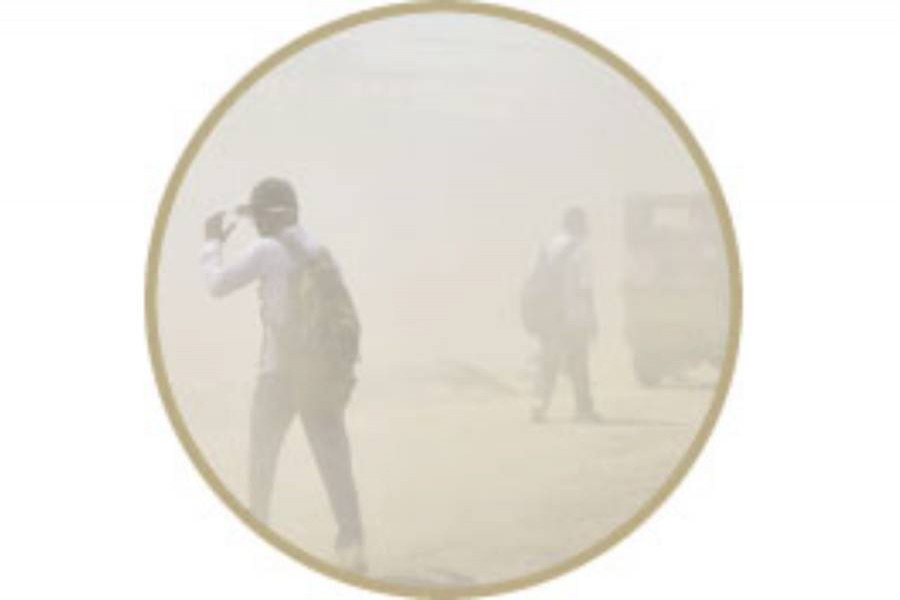A recent World Bank (WB) report says that a substantial proportion of the pollution in Dhaka's air is not of local origin. So is the case with Chattogram and Khulna. Human activities that cause air pollution are taking place within these cities and in different districts around them. Undoubtedly, those are the major contributors to the air pollution of Dhaka, Chattogram and Khulna. But the WB report further says that close to one-third (30 per cent, to be exact) of the pollutants in the air of these three districts come from across the Indian border. Similarly, polluted air from Bangladesh blowing westward does also affect air quality on the other side of the border. That, in other words, means that air pollution is not entirely a local phenomenon. From this perspective, fighting air pollution in a particular area is not the exclusive responsibility of the country to which it belongs, but it is a shared one. So, if the air pollution of any particular country is to be effectively addressed, cooperation with the neighbouring countries is essential.
Consider the case of Dhaka city. The WB report shows that about 40 per cent pollution of Dhaka's air is due to natural causes and human actions taking place within the city. But 28 per cent of the pollution is of regional, especially, of Indian origin. And the rest, 60 per cent of the pollution originates from the adjacent divisions and districts. In this connection, it is also important to know the types of pollution being talked about. Here the pollutants are mostly dust, dirt, soot, smoke, fumes, liquid droplets, etc. Sources of these pollutants are varied including automobiles, power plants, factories, brick fields, unpaved roads and construction sites. These pollutants are generally termed Particulate Matter (PM). And the kind of pollution they create is known as particle pollution. The particles of polluting agents as noted in the foregoing are large enough to be seen with the naked eye. They belong to the category of what is known as coarse PM. There is yet another kind of pollutant, the fine PM, which is so small that one needs an electron microscope to see them.
As for instance, PM10 includes particles that are 10 micrometres or less in diameter. (A micrometre is one millionth of a metre). These particles can enter the human body through inhalation. Similarly, the still smaller particles of size 2.5 micrometres or smaller (fine PM) are in the category of PM2.5. How small is M2.5?Compared to the thickness of hair, which is 70 micrometres in diameter, a pollutant particle of size PM2.5 is about 30 times thinner. These particles can enter the bloodstream through inhalation and are, therefore, a source of serious health hazard.
A study conducted between April, 2021 and March of this year at 10 spots within Dhaka city to determine the level of air and sound pollution came up with results that are concerning. It found that the presence of particulate matter of the type PM2.5 in Dhaka's air was five times the ideal level of 15 microgram (millionth of a gram) per cubic metre. On the other hand, the proportion of PM10 was found to be twice the accepted level. In Shahbag area of Dhaka city, for instance, the presence of PM2.5 was 85 microgram per cubic metre of air. In the Jatiya Sangsad (National Assembly) area, on the other hand, the figure was 70 microgram. These figures are a reminder of the fact that the level of particle pollution in the city has far exceeded the danger mark. Needless to say, the capital city has already become a living hell for its population. The study report in question made public by the Water Keepers Bangladesh Consortium also included the level of sound pollution in different parts of the city. Of the 10 spots studied, the level of sound pollution was found to be the highest in Gulshan-2 area at 95.40 decibels. This is 1.7 times the acceptable limit at 55 decibels.
In fact, 99 per cent of the world's population is affected by polluted, dirty air and the overwhelming majority of the sufferers are the poor working people. In this context, another WB study found that in 2019, air pollution alone was responsible for the deaths of 78,000 to 88,000 people. Small wonder that in the decade 2009- 2019, air pollution has been identified by the WB as the second strongest risk factor causing most deaths and disabilities in Bangladesh. While sound pollution can be addressed at the local level by the government through strong restrictive measures on the sources of the sound, the particle pollution will require regional cooperation. It may be recalled at this point that the UN Secretary-General, António Guterres, on the International Day of Clean Air for Blue Skies (September 7), declared that clean air is a human right and that air pollution knew no borders. That is why he stressed that to fight it, nations must work together.


